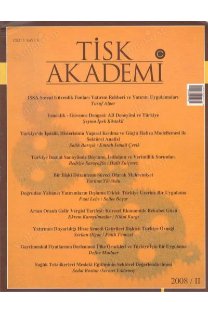Arzın merkezine seyahat: Bankacılarla yapılan görüşmelerden elde edilen bilgilerle Türk bankacılık sektörünün davranışı
Behaviour of banking sector in Turkey, based on information from survey
___
- Bassett, W.F., Chosak, M.B., Driscoll, J.C. ve Zakrajsek, E. (2010). Identifying the Macroeconomic Effects of Bank Lending Supply Shocks. (December 21, 2010). Available at SSRN: http://ssrn.com/abstract=1758832
- Bernanke, B.S. ve Gertler M. (1995). Inside the Black Box: The Credit Channel of Monetary Policy Transmission. Journal of Economic Perspectives. vol. 9 (Fall). pp. 27-48
- Bernanke, B., Gertler, M. ve Gilchrist, S. (1996). The financial accelerator and flight to quality. Review of Economics and Statistics. 78: 1-15
- Ciccarelli, M., Maddaloni, A. ve Peydró, J-L. (2010). Trusting the bankers: a new look at the credit channel of monetary policy. ECB Working Paper Series. No.1228. European Central Bank
- Clarida, R., Galí, J. ve Gertler M. (1999). The Science of Monetary Policy: A New Keynesian Perspective. Journal of Economic Literature. Vol. XXXVII (December 1999). pp. 16611707
- Del Giovane, P., Eramo, G. ve Nobili, A. (2010). Disentangling Demand and Supply in Credit Developments: A Survey-Based Analysis for Italy. (June 30, 2010). Bank of Italy Temi di Discussione (Working Paper). No. 764. Bank of Italy
- Disyatat, P. (2011). The Bank Lending Channel Revisited. Journal of Money, Credit and Banking. Blackwell Publishing. vol. 43(4). pages 711-734, 06
- Kiyotaki, N. ve Moore, J.(1997). Credit Cycles. Journal of PoliticalEconomy. v105 (2 Apr). 211-248
- Lehmann, E., ve Neuberger D. (2001). Do Lending Relationships Matter? Evidence from Bank Survey Data in Germany. Journal of Economic Behavior and Organization. 45, 339-359
- Luna-Martinez, J. de ve Vicente, C. L. (2012). Global Survey of Development Bank. World Bank Policy Research Working Paper No. 5969. February 2012
- Mojon, B. (2000). Financial structure and the interest rate channel of ECB monetary policy. ECB Working Paper. No. 40
- Smets, F. ve Wouters, R. (2003). An Estimated Dynamic Stochastic General Equilibrium Model of the Euro Area. Journal of the European Economic Association. MIT Press. vol. 1(5). pages 1123-1175, 09
- Weinberg, J.A. (1995). Cycles in lending standards? Economic Quarterly, Federal Reserve Bank of Richmond. issue Sum. pages 1-18
- ISSN: 1306-6757
- Yayın Aralığı: 2
- Başlangıç: 2006
- Yayıncı: Türkiye Isveren Sendikalari Konfederasyonu
Türkiye'de yabancıların çalışma şartları
Koray ALPER, Defne KURUL MUTLUER, Ramazan KARAŞAHİN, Hakan ATASOY
Bıst-100 Getirileri,dışticaret açığı ve enflasyon büyümesinin nedensellik açısından analizi
Türkiye elektrik piyasası reformunun elektrik fiyatlarına etkisi: Ampirik bir analiz
BEGÜM YURTERİ KÖSEDAĞLI, OSMAN AYDOĞUŞ
Ekonomik büyüme ve işsizlik ilişkisi: türkiye örneği
Türk endüstri ilişkiler sisteminde 2010 anayasa değişikliği ve sonrası gelişmeler
